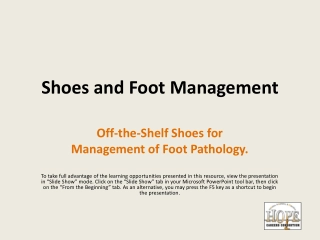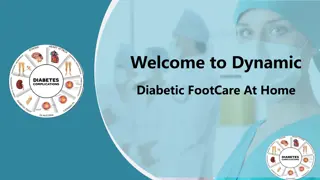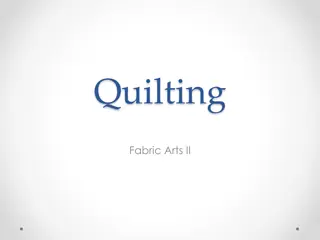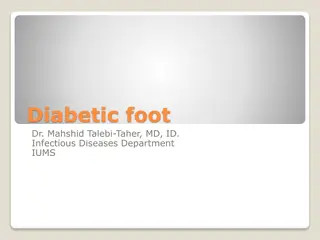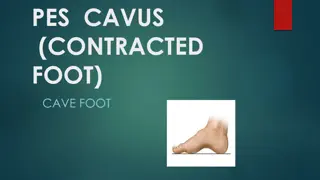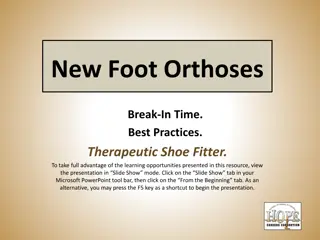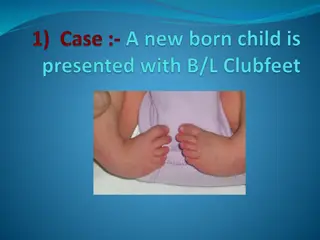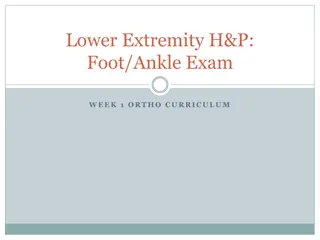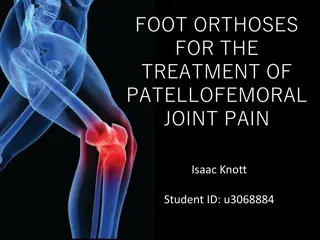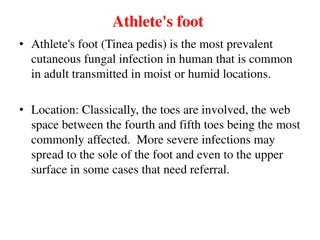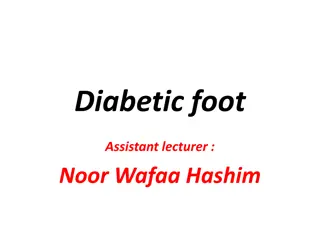The Diabetic Foot Exam: Tips, Tools, and Techniques
Explore a comprehensive resource on conducting diabetic foot exams, including steps, sample forms, best practices, and neurological assessments. Learn about patient history, general inspection, musculoskeletal assessment, risk classification, and more. Utilize provided videos and links for a better understanding of performing a thorough examination. Enhance your knowledge and skills in diabetic foot care to deliver effective patient management and education.
Download Presentation

Please find below an Image/Link to download the presentation.
The content on the website is provided AS IS for your information and personal use only. It may not be sold, licensed, or shared on other websites without obtaining consent from the author. Download presentation by click this link. If you encounter any issues during the download, it is possible that the publisher has removed the file from their server.
E N D
Presentation Transcript
The Diabetic Foot Exam Tips, Tools, and Techniques. To take full advantage of the learning opportunities presented in this resource, Internet access is recommended. Also, view the presentation in Slide Show mode. Click on the Slide Show tab in your tool bar, then click on the From the Beginning tab. As an alternative, you may press the F5 key as a shortcut to begin the presentation.
The Diabetic Foot Exam: Contents. Foot and Ankle Exam: General Procedures with Link to Video. Diabetic Foot Exam: Steps, Links to Sample Forms, Overview with Link to Video. Neurological Assessments: Monofilament Exam: Procedures with Link to Video; Vibration Exam: Procedures with Link to Video; Ankle Reflex Exam: Procedures with Link to Video. Risk, Management, and Care Classifications. Review: Patient Care.
A Musculoskeletal Exam of the Foot and Ankle: General Procedure. LOOK for nail and skin changes. FEEL for pulse and temperature. Have Patients: MOVE to determine range of motion (inversion, eversion, dorsiflexion, plantarflexion). STAND to observe toe and hindfoot alignment, foot arch. WALK to observe gait.
The Foot and Ankle Exam Video. Click on the video below to gain a better understanding of how a general foot and ankle exam is performed. Link to Video: Examination of the Foot and Ankle.
Diabetes Foot Exam: Steps. PATIENT HISTORY. GENERAL INSPECTION. SKIN INSPECTION. MUSCULOSKELETAL ASSESSMENT. NEUROLOGICAL ASSESSMENT. VASCULAR ASSESSMENT. RISK CLASSIFICATION. FOOTWEAR ASSESSMENT. EDUCATION. MANAGEMENT PLAN.
Diabetes Foot Exam: Sample Forms. Click on the links below to view sample diabetes foot examination forms. Link to sample form 1: Comprehensive Diabetes Foot Examination Form. Link to sample form 2: Screening for the High Risk Diabetic Foot: A 60-Second Tool.
The Diabetic Foot Exam: Best Practices. Click on the video below to gain a better understanding of the best practices in conducting a diabetic foot exam. Link to Video: Diabetic Foot Exam.
The Diabetic Foot Exam: More About Neurological Assessments: From the American Diabetes Association: When screening for nerve damage or loss of protective sensation (LOPS), check for numbness by using a monofilament test plus one additional sensation test, such as vibration or ankle reflex.
Neurological Foot Exams: MONOFILAMENT TEST (10 g). Equipment: Single strand of bendable manmade fiber (often a type of fishing line). General Procedure: Place monofilament perpendicular to the skin. Press against various parts of the foot until monofilament bends. Hold for one second, then release. Have patients indicate when / if they feel the monofilament touching their feet. Test at least ten locations nine on plantar surface, one on dorsal surface.
Neurological Foot Exams: MONOFILAMENT TEST. Click on the video below to gain a better understanding of the monofilament test. Link to Video: Neurologic Examination of the Foot: The 10gm Monofilament Test.
Neurological Foot Exams: VIBRATION TEST. Equipment: Tuning fork. General Procedure: Tap the tuning fork on the palm of your hand. Lightly press vibrating fork against the toes and other parts of the foot. Have patients indicate when and if they feel the fork vibrating or buzzing against their feet. An abnormal test occurs when the patient feels the vibration stop before you do.
Neurological Foot Exams: VIBRATION TEST. Click on the video below to gain a better understanding of the vibration test. Link to Video: Neurologic Examination of the Foot: 128 Hz Tuning Fork Test.
Neurological Foot Exams: ANKLE REFLEX TEST. Equipment: Tendon hammer. General Procedure: Have patient dorsiflex the foot at the ankle, positioning the joint at approximately 90 degrees. Tap the patient s Achilles tendon using a tendon hammer. When tapped, a normal foot will reflexively point downward. An absence of reflex may indicate an increased risk of foot ulceration.
Neurological Foot Exams: ANKLE REFLEX TEST. Click on the video below to gain a better understanding of the ankle reflex test. Link to Video: Neurologic Examination of the Foot: Ankle Reflexes.
Risk, Management, and Care: Industry-Recognized Risk Classification System (variations exist). 0 No Loss of Protective Sensation (LOPS) in feet. Action: Education, Annual Follow Up, Advise Appropriate Footwear; Track Problems. 1 LOPS in feet plus possible deformity. Action: Education, 3 to 6 Month Follow Up, Consider Prescriptive or Accommodative Footwear. 2 LOPS and Peripheral Arterial Disease (PAD). Action: Education, 1 to 3 Month Follow Up, Consider Prescriptive or Accommodative Footwear. 3 History of plantar ulcers or Charcot foot. Action: Education, 1 to 12 Weeks Follow Up, Consider Prescriptive or Accommodative Footwear; Consider Vascular Consultation.
REVIEWPATIENT CARE: 1. Encourage patients to inspect their feet daily. 2. Factors that might make it difficult for diabetics to practice good foot care include poor vision and reduced mobility. In these cases, encourage them to get additional support. 3. If you tell patients to wash and dry their feet daily and to apply cream to the dry areas, you must always add that they NOT apply cream between the toes. 4. Advise patients to see a doctor immediately when a foot ulcer develops. 5. Always check and inspect the type of footwear the patient wears. Two tips of advice: Wear closed-toe shoes that provide support and seamless socks.
REVIEWKNOWLEDGE CHECK: Test your knowledge of the material with the following questions.
REVIEWKNOWLEDGE CHECK: 1. What does LOPS stand for? Answer: Loss of Protective Sensation. 2. What does PAD stand for? Answer: Peripheral Arterial (or Artery) Disease. 3. During a foot and ankle exam, you will look for nail and skin changes, and feel for pulse and temperature. Then, you will have the patient do what three activities? Answer: Move, stand, and walk.
REVIEWKNOWLEDGE CHECK: 4. The American Diabetes Association recommends that, regarding neurological assessments, you should perform a (blank) test plus one additional sensation test, such as (blank) or (blank). Answer 1: Monofilament test. Answer 2: Vibration test or ankle reflex test.
REVIEWKNOWLEDGE CHECK: 5. Which of the following neurological assessments involves testing at least ten locations nine on plantar surface, one on dorsal surface? A. Vibration test. B. Monofilament test. C. Ankle reflex test. Answer: Monofilament test.
REVIEWKNOWLEDGE CHECK: 6. When using a (blank), an abnormal test occurs when the patient feels the vibration stop before you do. A. Monofilament. B. Straight pin. C. Tendon hammer. D. Tuning fork. Answer: Tuning fork.
REVIEWKNOWLEDGE CHECK: 7. It is a best practice to encourage diabetic patients to inspect their feet: A. Weekly. B. Only after they bathe. C. Daily. D. Once or twice a week. Answer: Daily.
The Diabetic Foot Exam This workforce product was funded by a grant awarded by the U.S. Department of Labor s Employment and Training Administration. The product was created by the grantee and does not necessarily reflect the official position of the U.S. Department of Labor. The U.S. Department of Labor makes no guarantees, warranties, or assurances of any kind, express or implied, with respect to such information, including any information on linked sites and including, but not limited to, accuracy of the information or its completeness, timeliness, usefulness, adequacy, continued availability, or ownership. Produced 2016. HOPE Careers Consortium is a partnership of five institutions of higher education that is building exciting new programs that will provide valuable career education and training in the Orthotics, Prosthetics, and Pedorthics (O&P) sector. The five institutions are: Baker College Flint, Michigan; Century College White Bear Lake, Minnesota; Oklahoma State University Institute of Technology Okmulgee, Oklahoma; Spokane Falls Community College Spokane, Washington; and St. Petersburg College St. Petersburg, Florida. Although the authoring institution of this educational resource has made every effort to ensure that the information presented is correct, the institution assumes no liability to any party for any loss, damage, or disruption caused by errors or omissions. This work by Oklahoma State University Institute of Technology (OSUIT) is licensed under the Creative Commons Attribution 4.0 International License. To view a copy of this license, click on the following link: Creative Commons Licenses 4.0.


